|
|
Birds
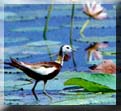 The
abundance of Sri Lanka's birdlife makes it an ornithologist's paradise. Of the
431 recorded species 251 are resident and no less than 21 are endemic to the
island. Most of the endemic birds are restricted to the wet zone, e.g. the
Ceylon Grackle or to the hill - country, e.g. the Ceylon Whistling Thrush, the
Yellow-eared Bulbul etc. Some, such as the striking Redfaced Malkoha and the
shy brown-capped Babbler can be found through out the island although confined
to small areas of forests, National Parks and Forest Reserves. Among the best
areas for these birds are the Sinharaja Forest Reserve and the Peak Wilderness
Sanctuary. Around mid August the first flocks of the species begin to arrive
with large numbers of sandpipers, stilts, plovers, terns, etc. coming from
Siberia, Scandinavia and Western Europe. In the forested areas migratory tree
warblers, thrushes, cuckoos etc. can be seen. The large 'tanks' (reservoirs) in
the dry zone attract numerous types of ducks, while the large water birds - the
storks, herons and egrets - can be easily spotted in the National Parks. The
Kumana Bird Sanctuary in the Eastern Province and Bundala, Kalametiya and
Wirawila in the south, abound in these aquatic birds. Bundala is especially
famous for its flocks of visiting flamingoes. The
abundance of Sri Lanka's birdlife makes it an ornithologist's paradise. Of the
431 recorded species 251 are resident and no less than 21 are endemic to the
island. Most of the endemic birds are restricted to the wet zone, e.g. the
Ceylon Grackle or to the hill - country, e.g. the Ceylon Whistling Thrush, the
Yellow-eared Bulbul etc. Some, such as the striking Redfaced Malkoha and the
shy brown-capped Babbler can be found through out the island although confined
to small areas of forests, National Parks and Forest Reserves. Among the best
areas for these birds are the Sinharaja Forest Reserve and the Peak Wilderness
Sanctuary. Around mid August the first flocks of the species begin to arrive
with large numbers of sandpipers, stilts, plovers, terns, etc. coming from
Siberia, Scandinavia and Western Europe. In the forested areas migratory tree
warblers, thrushes, cuckoos etc. can be seen. The large 'tanks' (reservoirs) in
the dry zone attract numerous types of ducks, while the large water birds - the
storks, herons and egrets - can be easily spotted in the National Parks. The
Kumana Bird Sanctuary in the Eastern Province and Bundala, Kalametiya and
Wirawila in the south, abound in these aquatic birds. Bundala is especially
famous for its flocks of visiting flamingoes. An interesting place to visit
for more bird life is the Muthurajawela marshes, just outside the northern
border of the Colombo city.

Butterflies
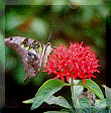 |
To the naturalist, Sri Lanka offers a tantalising array of interesting and
unique forms. Of the 242 known species, most are found in the regions of the
lower foothills (i.e. up to 910 metres). A few (6 species) can be glimpsed
above 1210 metres. A most spectacular scene is the seasonal migration of
butterflies during March and April, when tradition has it that they fly towards
'Samanala Kande' (Butterfly Peak), the local name for the mountain more famous
as 'Sri Pada' or `Adam's Peak'. |

Vertebrates
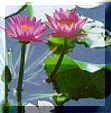 Of the 86 species of mammals the pride of place goes to the majestic elephant.
Although rapid destruction of its habitat has depleted the elephant population,
sizeable numbers can be seen in Gal Oya and Udawalawe National parks and at
Handapangala. Extinction also threatens the island's biggest cat - the leopard,
although Wilpattu National park is justifiably proud of its leopard population.
Many species of deer - the Sambhur, the Hog Deer, the Mouse deer can also be
seen in the Parks.
Of the 86 species of mammals the pride of place goes to the majestic elephant.
Although rapid destruction of its habitat has depleted the elephant population,
sizeable numbers can be seen in Gal Oya and Udawalawe National parks and at
Handapangala. Extinction also threatens the island's biggest cat - the leopard,
although Wilpattu National park is justifiably proud of its leopard population.
Many species of deer - the Sambhur, the Hog Deer, the Mouse deer can also be
seen in the Parks.
Other mammals include the Sloth Bear, the protected Dugong, the Wild Boar,
the Porcupine and Monkeys, especially the Grey Langur, which are common
throughout the island. Of special interest is the endemic purple faced Leaf
Monkey, found in the higher hill regions.
All major groups of vertebrates to be found in Sri Lanka, are mostly endemic
to the island, especially the amphibians and reptiles. Most of the 54 species
of fish are marsh and river dwelling fish, the 14 endemic species being
restricted to the perennial streams of the wet zone. They are the beautiful
fish of the Carplet group. The British introduced 16 species into the island
including the Trout found today in the clear, cold streams of Horton plains. Of
the 38 species of amphibia, 16 are unique to the island. One endemic genus, the
Nannophrys, with 3 species, is common in the hill country. This frog lives on
rock ledges covered by a continuous trickle of water and tadpoles share this
habitat. None of the amphibians are poisonous to man.
The island abounds in reptiles of which 75 are endemic. Of the 2 endemic
species of Crocodile, the commonest is the Marsh Crocodile. The beautiful Star
Tortoise is the only land tortoise. All 5 species of Turtles are protected by
law. Of the 83 species of snakes, only 5 are lethal, these being Cobra,
Russell's Viper, Indian Krait, Ceylon Krait, and the Saw-scaled Viper. These
are rarely found in builtup areas of city or village.

Flowers & Trees
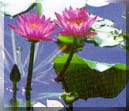 To the botanist this is indeed a land of plenty. The diversified climate allows
for trees, tropical as well as temperate. The luxuriant undergrowth and tall
majestic trees of the wet-zone tropical forests contrast with the arid
scrubland and talipot palms of the dry north and east. In the hills, vegetation
varies from the almost tree-less patanas - Moon plains, Elk Plains, etc. to the
dark Rhododendron forests, wreathed with the protected Spagnum Moss, to the
gorse covered Horton Plains. From March to May numerous flowering trees such as
the fiery Poinciana Regia, the white Mesua Ferrea, the cherry blossom-like
Tabebuia, burst into bloom. Flowering orchids include endemic varieties such as
the protected Daffodil and Wesak Orchids.
To the botanist this is indeed a land of plenty. The diversified climate allows
for trees, tropical as well as temperate. The luxuriant undergrowth and tall
majestic trees of the wet-zone tropical forests contrast with the arid
scrubland and talipot palms of the dry north and east. In the hills, vegetation
varies from the almost tree-less patanas - Moon plains, Elk Plains, etc. to the
dark Rhododendron forests, wreathed with the protected Spagnum Moss, to the
gorse covered Horton Plains. From March to May numerous flowering trees such as
the fiery Poinciana Regia, the white Mesua Ferrea, the cherry blossom-like
Tabebuia, burst into bloom. Flowering orchids include endemic varieties such as
the protected Daffodil and Wesak Orchids.

Special Note
The law protects certain endangered species of flora and fauna. Export and even
possession of these species as well as live animals, birds, reptiles is
illegal. Please also remember that production and sale of items made from wild
animals and reptiles is illegal. Occasional exports are however permitted
exclusively for bona fide scientific purposes and all applications for any such
export should be made to the Director of Wildlife Conservation.

Fruits & Spices
 Sri Lanka has a year round abundance of fresh fruits - Pineapple,
papaya, banana and mango are plentiful throughout the year. Between the months
of July and October, mangoosteen, passion fruit, avocado, pear, durian,
rambuttan and oranges are also available. For centuries spices have been one of
Sri Lanka's most celebrated exports, among them cinnamon, nutmeg, cloves,
cardamom, pepper, etc. Sri Lanka has a year round abundance of fresh fruits - Pineapple,
papaya, banana and mango are plentiful throughout the year. Between the months
of July and October, mangoosteen, passion fruit, avocado, pear, durian,
rambuttan and oranges are also available. For centuries spices have been one of
Sri Lanka's most celebrated exports, among them cinnamon, nutmeg, cloves,
cardamom, pepper, etc.
The Spice Garden at the Royal Botanic Gardens, Peradeniya has the most
complete collection of spice plants and high quality fresh packeted spices are
freely available for sale, especially in Kandy. There are also many private
spice gardens open to the public.

Tea
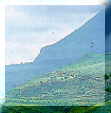 |
Sri Lanka is the world's leading producer of high quality tea, which is our
main export. Most itineraries which include hill country resorts also include a
visit to a tea estate and factory to see production and processing which is
done in some of the most scenic areas of the island. Every visitor is allowed 3
kilos of tea for export, duty free, and it is readily available everywhere.
Excess over this quantity is dutiable.
|

Rubber
Another large export item rubber was introduced by Sir Henry Wickham, who
cultivated seedlings from seeds brought from Brazil in 1876. The milk like
latex is tapped from the bark and made into crepe or sheets for export. The
plantations are mainly in the south western zone of the island.

Coconut
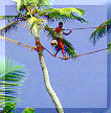 |
Coconut grows widely in the coastal regions of the wet zone. Described as
the 'tree of life' every part of it is made use of. Coconut milk, the extract
of the kernel, is used for daily cooking. Other products obtained from coconut
are oil, copra, dessicated coconut, vinegar and arrack, the local drink.
Coconut fibre is used to make rope, rugs, matting, brooms and brushes. |

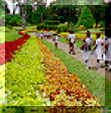 |
Sri Lanka has three beautiful Botanic Gardens - Peradeniya at an elevation
of 488 metres, Hakgala at an elevation of 1,680 metres and Henarathgoda in the
low country. |

|

![]() View
My Guestbook
View
My Guestbook